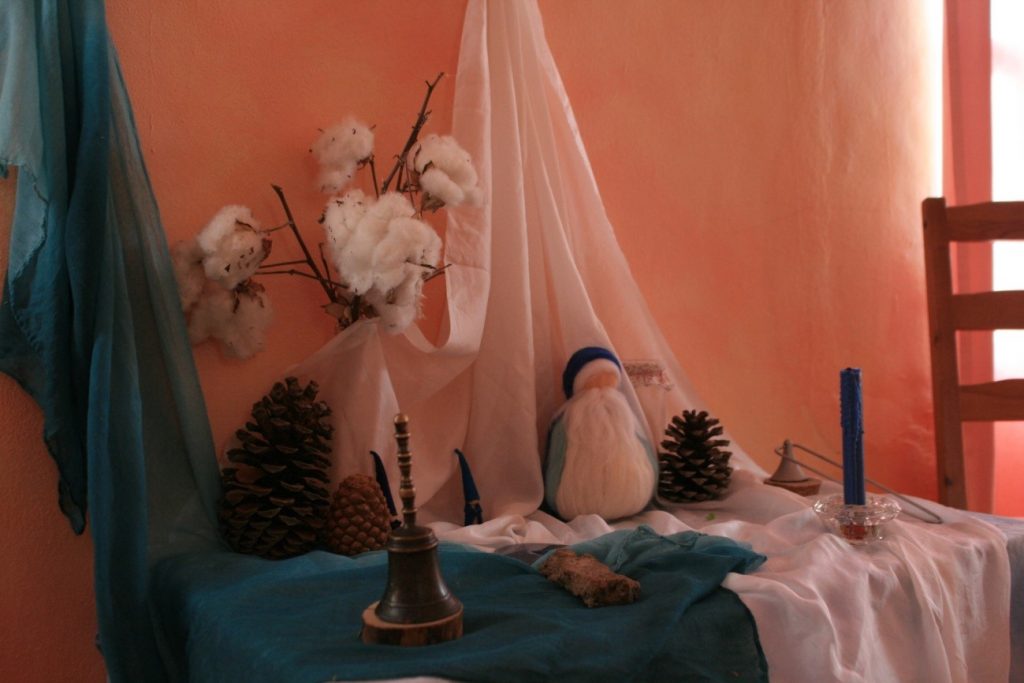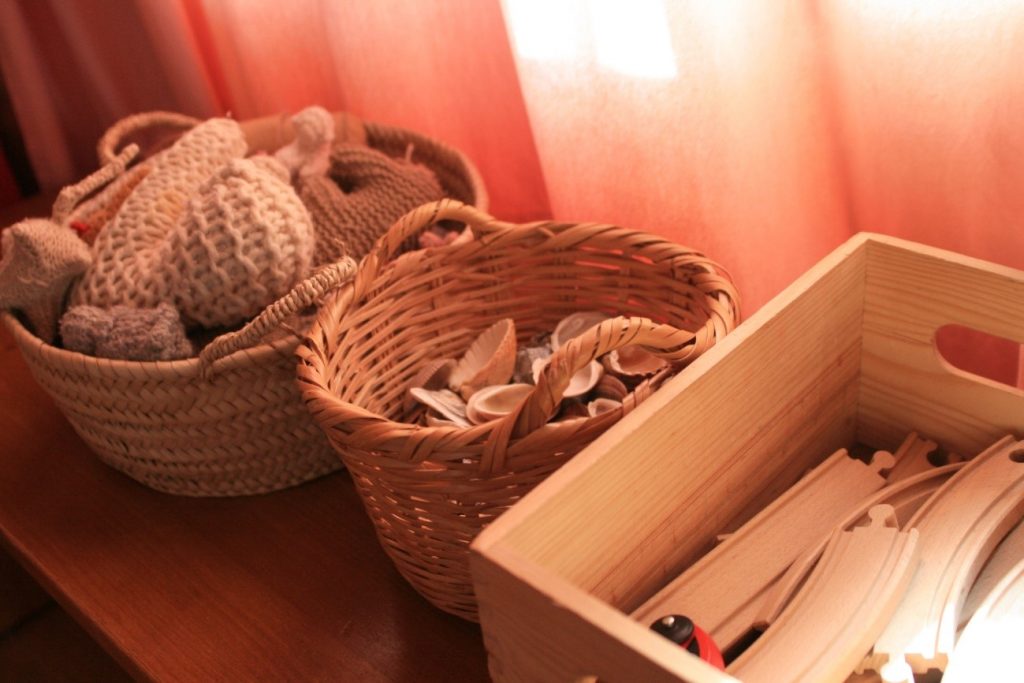In our physically beautiful, emotionally supportive and carefully structured homelike environment, the child’s day naturally flows between social and individual activities that reflect the child’s need for both active and quiet play. We provide a safe, responsive, and nurturing environment that meet the needs of children and help them to develop comprehensively.
Children enter Kindergarten between the ages of 3 and 6 years old and we have two mixed-age kindergarten classes at school. We maintain a teacher-student ratio of 1:17 and each class has a teacher assistant working with the class teacher.
Our program is five-morning sessions per week. Classes start at 9:00 am and finish at 2:00 pm. We have an afternoon care program that is offered to the families who need it.
In recognition of its vital role in early education, children have many opportunities to play during the day.
Watercolor painting, handcrafts, beeswax modeling, baking, imaginative play, puppetry, music, or circle games. All the activities are focused on doing and experimenting. Activities involve feeling, touching, exploring and imitating while children find their way into the experiences at their path. We include a varied repertoire of songs, stories, and poems and also purposeful work such as watering the plants, setting the table for breakfast, cutting the fruits, untangling classroom ropes, picking up trash, making clothespins from split sticks wrapped with wire, washing outdoor tools, toys or placemats and other cloth items.
Seasonal activities and festivals celebrate the cycles of the year, and there is a rhythmic alternation between the ‘child’s time’ (creative play, outside time) and the teacher’s time (story or circle time). The rhythmic repetition of these activities strengthens and nourishes the children, imbuing them with a sense of order and harmony.
The role of the educator is essential. The Waldorf Kindergarten teacher is a specially trained person able to create a wholesome environment that nurtures the physical, emotional, social and spiritual development of each child and prepares them for the elementary grades.
Rudolf Steiner, speaking in Oxford in 1922, defined «three golden rules» for teachers: «to receive the child in gratitude from the world it comes from; to educate the child with love, and to lead the child into the true freedom which belongs»
OUR BASES:
HOMELIKE ENVIRONMENT
We create an environment that simulates, as closely as possible, the warmth and activity of a traditional home. As the children engage in daily activities, the teachers engage in the work of the classroom, including the children whenever possible. They prepare the snack, wash the napkins, sweep, dust, set the table, fold the towels—all meaningful work, necessary for the class to function. Work is presented not as a chore, but as a willing gift of love in which everyone participates.
RHYTHM
This is one of the most important issues in Steiner’s pedagogy, as every day in a Waldorf school is organized following the same patterns. The same things take place at the same time every day, giving our children confidence and a feeling of routine. A daily rhythm alternates carefully between expanding and contracting activities, helping to situate them in their time and place, and giving them the balance to grow up in a healthy way. Each day during the week has a specific activity, so Mondays they paint with watercolors, on Tuesday they make their own bread, the day after they prepare vegetable soup, on Thursdays, our children paint with crayons or mold with beeswax, and on Friday they work in the garden. Every season has its peculiarity, and we have a “Nature Table” which shows the rhythm of the year in each classroom, with its changing colors, and little characters, such as gnomes that help the trees and flowers grow up, and also the different festivities: the Harvest Feast, Martin Lantern Walk, Advent Spiral, etc.

FREE PLAY
Free play is itself a current topic and the most important on Waldorf Kindergarten. It is a way to explore the environment, and a mean to understand their cultural background; it helps to dominate their movements, their balance, creativity, imagination, and also their mood, finding their own mode of expression. It also allows the emergence described on pre-school programs, such as language, as verbal interactions are ever-present, social skills, emotional development, cognitive development, by playing with undefined toys or objects, and personal development. Free play is more than a game for our children; it is their “duty”.

ARTISTIC ACTIVITIES
Every day our children do a different activity as we mentioned before, such as painting with watercolors or crayons, moldings with beeswax, kneading the dough to make bread… but all these activities take place in an artistic way, which helps develop the sensitivity in our children, together with the development of the senses itself.
TOYS AND TOOLS
Waldorf toys are quite different, they are basic and undefined so that the kids can develop their imagination and inner activity. Apart from that, we use specific, natural, high-quality materials, such as wood, wool, natural fabrics dyed with ecological tints, beeswax, cotton fabrics, silk, and also wood, branches, fruits or stones, children take from their outings. They are made by their own teachers and parent, and sometimes in front of them, so they can appreciate their value. Most of them are rag dolls, animals from their environment made by wool, cars made of wood, and wood pieces to make roads, tracks, bridges, etc.
BREAKFAST
During the free play inside of the classroom, Waldorf teachers prepare breakfast, sometimes even with the help of our children. The sense of smell is working at that time. We use ecological food, made by whole wheat, rice, repeated every day of the week; Mondays they eat rice, Tuesdays and Thursdays we have fruits and wholemeal bread, Wednesdays vegetable soup, and on Fridays they eat oatmeal. Our children help to set up the table and when we finish we clean together, which is an important activity as well.

SONGS, PLAYS AND VERSES
All human beings are musical beings. Folk music and music in a major key, pentatonic mode, together with verses and fingerplays take place in our kindergarten to accompany our children and bring the appropriate “soul food”. Music has its foundation in the spiritual realm and requires a human being to bring it into physical manifestation, that is why it helps children to be aware of their bodies and develop also their sense of rhythm. There are different songs specific for every season, and children perform them also on the celebrations along the year, they help to capture the passing of time.
HANDWORK
Kindergarten children learn through imitation, that is why our teachers work in front of them, preparing the objects they will need for the monthly festivities, such as lanterns for the “Lantern Festival”, painted eggs for the Easter celebration, butterflies in springtime, etc… All of the hands-on activities have a meaning and it makes sense to them.

FAIRY TALES
It is the best way to end a day full of activities. They have an enormous and irreplaceable value in the life of a child. Storytelling brings a living imaginative aspect to the lessons and meets the children where they are developmental. Children live in imagination and can digest and take in truths, archetypes, and content via imagination that is living, versus a dry, abstract or intellectual explanation of things. The subjects depend on their age, but also on the season and the coming feast. In a true fairy tale, human beings undergo trials and suffering and accept that deeds are a part of proving oneself worthy of the reward at the end of the path, whether the reward is the hand of the princess or a kingdom. They confront evil and overcome it. Folktales are also important to situate them in their time and place and help them to understand the culture they live in. We also have the fables, where animals incarnate human values, or legends, that ennoble the human being. The same tale is repeated every day, for some time, so children can learn them by heart and sometimes could end up being represented by puppets that their teachers have been elaborating in front of them. Through these narratives children learn to listen, they enrich their language and let their imagination fly.

TEACHERS
Rudolf Steiner defined «three golden rules» for teachers: «To receive the child in gratitude from the world it comes from; To educate the child with love, and To lead the child into the true freedom which belongs to man.» Our teachers love the magic and growth that happens in mixed-age Waldorf kindergarten. They are an essential reference for children and they help them to develop harmoniously.
FAMILIES
Families are one of the biggest supports in Waldorf education. This participation at the school life is based on the collaboration between families and teachers, but also on other practical tasks, such as maintenance, the organization of the monthly feasts, the elaboration of toys, and even economic support, making workshops, flea-markets, etc… We should also take into account that we, parent and teachers, are role models for our children, so we must live in harmony, fighting for what we believe and loving what we do.



